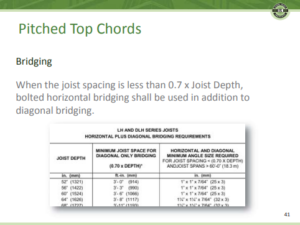Are you familiar with the recommendations from the Steel Joist Institute for the use of bridging on joists with pitched top chord? Are special considerations needed when using bottom chord bearing joists?
In the November 2022 SEU session, Ben Pitchford, PE, from New Millennium Building Systems, and Doug Hoffman, PE, from Vulcraft, presented Roof Design with Special Profile Joists. Ben and Doug identified important unique considerations when specifying steel joists and Joist Girders with pitched chords or radiused chords. They described the factors that impact special profile steel joists and gave tips to ensure designers can avoid additional RFIs during their projects.
Ben shared bridging tips for structural engineers to follow when designing with special profile steel joists. Engineers should be aware that pitched top chord steel joists often require more rows of bridging than parallel chord joists. Ben also noted that joists whose center of gravity is higher than its supports will require bolted erection bridging to prevent instability once the hoisting cables are released.
Special attention should be given to the termination of bridging and clear communication will be required between the engineer and the joist supplier. Ben recommends that bridging be terminated between the last two joists rather than attaching to the main structure to avoid misalignment between attachment points and to prevent having to use long, slender pieces of bridging which is not preferred.
Ben also pointed out that for joists whose spacing is less than 0.7 x joist depth, bolted horizontal bridging is required in addition to diagonal bridging. In this instance, the joists are so close together that the diagonal bridging becomes less effective, thus the added horizontal bridging provides further stability. SJI provides guidance for angle sizes required for various joist depths, as shown below.
For bottom chord bearing joists, a row of diagonal cross bridging is also required at or near the bearing location to provide additional lateral stability during erection. This diagonal bridging is also required due to the center of gravity being above the bearing location. All required erection bridging should be bolted to allow for ease of installation and efficiency.
Following these bridging recommendations can reduce the need for RFIs during construction administration. The Steel Joist Institute recommends the EOR reach out to the joist supplier with any concerns or to discuss using special profile joists and what bridging might be most appropriate for the project.

